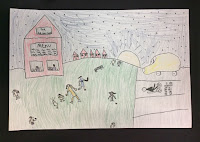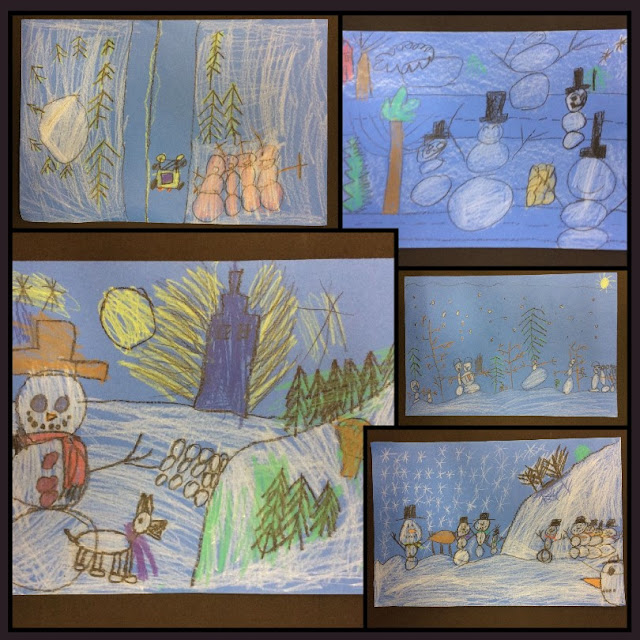Thursday, January 26, 2017
A six minute daily draw......prompt
My classes participate in a 6 minute silent draw when they first arrive at class each day. I tell them it is to help them engage their art brains. It allows me time to take attendance, switch out supplies and mentally prepare for the next grade level lesson. This month I added these light bulbs to my white board. They are laminated so I can use it just as I would my whiteboard. I am using the prompt from the #k12artchallenge as an additional daily prompt for the 6 minute day. Students still have the option to draw whatever they would like for the 6 minutes but if they are stuck, they now have a prompt.
Do you shop NAEIR?
Tuesday, January 24, 2017
Artistic Narratives - Introducing Norman Rockwell
 |
| student work |
Fifth grade students are completing a unit on Norman Rockwell. The focus was on the narrative qualities of his work. The complete lesson plan is further down in this post. I wanted to share some of their completed work with you. For the 2nd half of the lesson, I will be coordinating with one of their classroom teachers where they will be writing the narratives to accompany their illustrations. We plan to post work outside of both of our classrooms. I will post illustrations with a QR code link to the written work. She will post the QR code link to the illustrations along with their written work. This will be a great way for both of us to document collaboration in the curriculum.
 |
| student work |
 |
| student work |
 |
| student work |
 |
| student work |
 |
| student work |
 |
| student work |
Artistic Narratives
Overview: Fifth grade students will use artistic details to tell a narrative. They will then follow-up by writing the story to accommodate the work of art. Creating art in the Regionalism style of Norman Rockwell. (1894-1978)
Objective: As an Artist -
I can interpret or create a narrative depiction through art.
I can write a narrative based on the artistic detail of my work of art.
I can create and understand the use of visual cues to tell a story.
Materials: A variety of prints by the American Artist/Illustrator, Norman Rockwell
Pencil
9 x 12 white drawing paper
Medium of choice (crayons, markers, color pencils, watercolor…)
Week 1: Background history on artist of choice, Norman Rockwell.
Group analysis of a selected Norman Rockwell print with a focus on determining the narrative of the work and searching for the artistic details that contribute to the narrative. If time: break into table groups to analyze an additional work for collaborate sharing.
Week 2: Create in the illustration style of Norman Rockwell. Drawing first in pencil and remembering to add artistic details to enrich the narrative of the illustration.
Week 3-4: Continue to add two illustration with pencil if needed then using medium of choice begin to add color to the composition.
Week 4-5: Once illustration is completed, begin to write the accompanying narrative to tell the story of the work. Use a dictionary, supplied, to check all spelling. Look for good sentence structure and punctuation. Story is minimally two full pages, hand written. Once completed, publish both on Artsonia.
Rubric:
Refer to posted rubric in classroom to determine artistic development.
Saturday, January 14, 2017
Monet's Garden Mono Prints
 First grade students explored a little about Claude Monet this week and his role in the Impressionism movement. My students are investigating print making this month so I attempted a new twist on an old idea for them. You've all probably seen this project all over Pinterest. I don't know who the originator was but it is a terrific project for mono-printing with mixed media. It's terrific because the kids honestly are wowed by it as if it were magic. So with this project in mind, I do it with 2nd grade, I began to experiment for a Monet project that would give similar results with different mediums. I like the idea of focusing on Monet's Japanese garden and that very famous bridge that he has painted so many times. I also wanted to make students conscience of the impressionist style of Monet and not have them rely on just coloring in the picture. I pulled out the Payons, my 1st graders were using these for the first time so it would be a huge treat. I modeled the way they should used them as if they were painting with shot strokes of a brush. They were to be very mindful of using strokes of color and also the intentional direction of the stokes to create the effect we were hoping for of flowing water and growing plants.
First grade students explored a little about Claude Monet this week and his role in the Impressionism movement. My students are investigating print making this month so I attempted a new twist on an old idea for them. You've all probably seen this project all over Pinterest. I don't know who the originator was but it is a terrific project for mono-printing with mixed media. It's terrific because the kids honestly are wowed by it as if it were magic. So with this project in mind, I do it with 2nd grade, I began to experiment for a Monet project that would give similar results with different mediums. I like the idea of focusing on Monet's Japanese garden and that very famous bridge that he has painted so many times. I also wanted to make students conscience of the impressionist style of Monet and not have them rely on just coloring in the picture. I pulled out the Payons, my 1st graders were using these for the first time so it would be a huge treat. I modeled the way they should used them as if they were painting with shot strokes of a brush. They were to be very mindful of using strokes of color and also the intentional direction of the stokes to create the effect we were hoping for of flowing water and growing plants.Saturday, January 7, 2017
Pride
Making buttons today and watching it snow. Hopefully these will be a big hit at the Talent Show on Friday.
Tuesday, January 3, 2017
Illusion of Space with 2nd graders
This lesson has been a yearly project for too many years to remember. This year the 2nd graders seem to have knocked it out of the park. The focus is on creating the illusion of space in a composition. I used the wonderful "Snowmen at Night" series of books by Caralyn Buehner to kick off the project. Her husband, Mark is responsible for the wonderful illustrations. I chose a few of his illustrations for students to examine and determine what methods are being used to create Space. They identify the use of linear perspective, overlap, placement, and size in the images. Then they are off to create their own work emphasizing the four ways to show space. I keep this poster visible to assist them with their planning.
They are task with comparing their work to the poster and determining whether they have included all four methods. Because these are created in early winter, snowmen is the subject of the composition. I am really impressed with the imagination and craftsmanship exhibited by these young artist.
 |
| Instructional poster for reference |
 |
| Student works from 2017 |
Subscribe to:
Comments (Atom)




